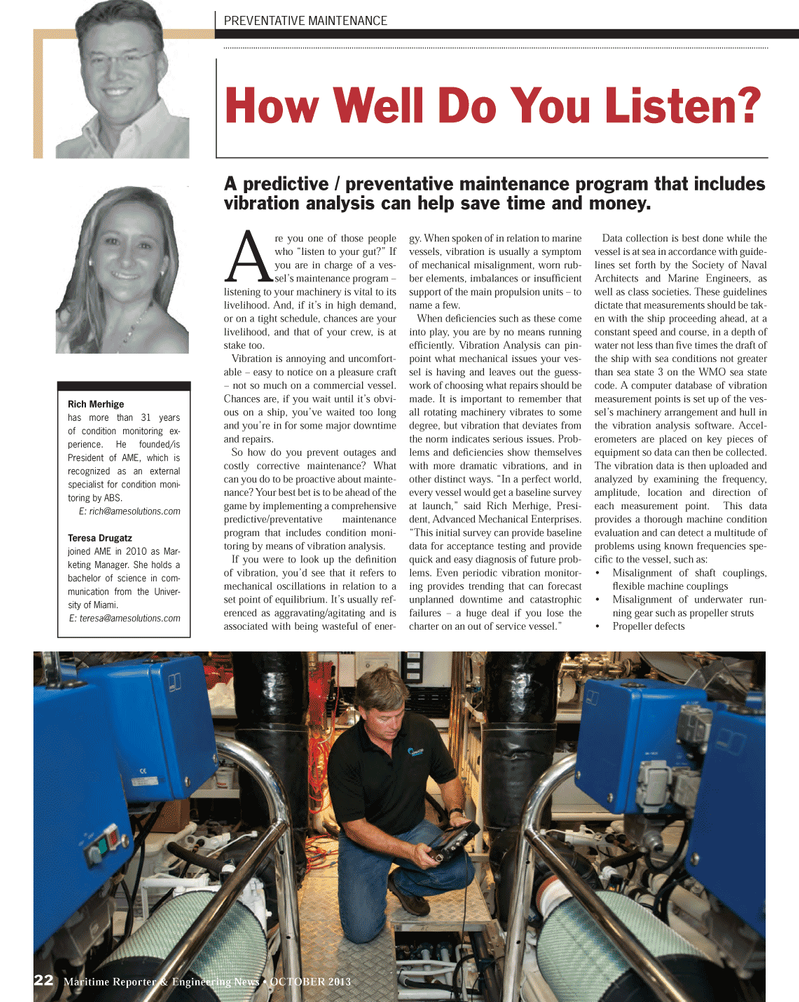
Page 22: of Maritime Reporter Magazine (October 2013)
Marine Design & Construction
Read this page in Pdf, Flash or Html5 edition of October 2013 Maritime Reporter Magazine
PREVENTATIVE MAINTENANCE How Well Do You Listen? Are you one of those people who ?listen to your gut?? If you are in charge of a ves- sel?s maintenance program ? listening to your machinery is vital to its livelihood. And, if it?s in high demand, or on a tight schedule, chances are your livelihood, and that of your crew, is at stake too. Vibration is annoying and uncomfort- able ? easy to notice on a pleasure craft ? not so much on a commercial vessel. Chances are, if you wait until it?s obvi- ous on a ship, you?ve waited too long and you?re in for some major downtime and repairs.So how do you prevent outages and costly corrective maintenance? What can you do to be proactive about mainte-nance? Your best bet is to be ahead of the game by implementing a comprehensive predictive/preventative maintenance program that includes condition moni-toring by means of vibration analysis. If you were to look up the deÞ nition of vibration, you?d see that it refers to mechanical oscillations in relation to a set point of equilibrium. It?s usually ref- erenced as aggravating/agitating and is associated with being wasteful of ener- gy. When spoken of in relation to marine vessels, vibration is usually a symptom of mechanical misalignment, worn rub-ber elements, imbalances or insufÞ cient support of the main propulsion units ? to name a few. When deÞ ciencies such as these come into play, you are by no means running efÞ ciently. Vibration Analysis can pin- point what mechanical issues your ves-sel is having and leaves out the guess-work of choosing what repairs should be made. It is important to remember that all rotating machinery vibrates to some degree, but vibration that deviates from the norm indicates serious issues. Prob-lems and deÞ ciencies show themselves with more dramatic vibrations, and in other distinct ways. ?In a perfect world, every vessel would get a baseline survey at launch,? said Rich Merhige, Presi-dent, Advanced Mechanical Enterprises. ?This initial survey can provide baseline data for acceptance testing and provide quick and easy diagnosis of future prob-lems. Even periodic vibration monitor- ing provides trending that can forecast unplanned downtime and catastrophic failures ? a huge deal if you lose the charter on an out of service vessel.?Data collection is best done while the vessel is at sea in accordance with guide-lines set forth by the Society of Naval Architects and Marine Engineers, as well as class societies. These guidelines dictate that measurements should be tak-en with the ship proceeding ahead, at a constant speed and course, in a depth of water not less than Þ ve times the draft of the ship with sea conditions not greater than sea state 3 on the WMO sea state code. A computer database of vibration measurement points is set up of the ves-sel?s machinery arrangement and hull in the vibration analysis software. Accel- erometers are placed on key pieces of equipment so data can then be collected. The vibration data is then uploaded and analyzed by examining the frequency, amplitude, location and direction of each measurement point. This data provides a thorough machine condition evaluation and can detect a multitude of problems using known frequencies spe-ciÞ c to the vessel, such as: ? Misalignment of shaft couplings, ß exible machine couplings ? Misalignment of underwater run- ning gear such as propeller struts? Propeller defects Rich Merhige has more than 31 years of condition monitoring ex-perience. He founded/is President of AME, which is recognized as an external specialist for condition moni-toring by ABS. E: [email protected] Drugatz joined AME in 2010 as Mar-keting Manager. She holds a bachelor of science in com-munication from the Univer- sity of Miami. E: [email protected] A predictive / preventative maintenance program that includes vibration analysis can help save time and money. 22 Maritime Reporter & Engineering News ? OCTOBER 2013 MR #10 (18-25).indd 22MR #10 (18-25).indd 2210/2/2013 3:48:36 PM10/2/2013 3:48:36 PM

 21
21

 23
23
